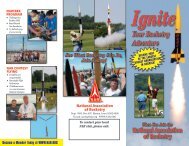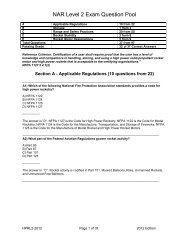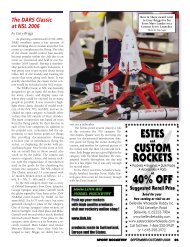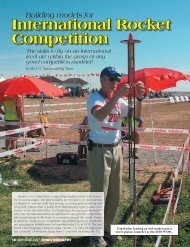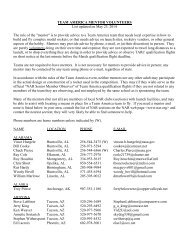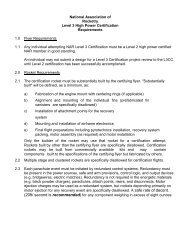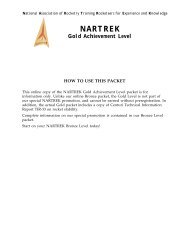Modular rockeTs Building Baffles - National Association of Rocketry
Modular rockeTs Building Baffles - National Association of Rocketry
Modular rockeTs Building Baffles - National Association of Rocketry
Create successful ePaper yourself
Turn your PDF publications into a flip-book with our unique Google optimized e-Paper software.
A Message from theNAR Presidentby Trip Barber, NAR 4322,NAR PresidentReaching OutThe key to the long-term survival <strong>of</strong>any activity or organization is to have atleast as many people joining it each yearas are departing. This is true <strong>of</strong> our hobbyand <strong>of</strong> our NAR. <strong>Rocketry</strong> is a hobby,something that people pursue if theyenjoy doing it and if they enjoy beingaround the other people who do it withthem. In order for our hobby and ourNAR to thrive, we need to convince a lot<strong>of</strong> people each year that rocketry is a funactivity that they can do safely, and thatthose <strong>of</strong> us who do it are good people tobe around. This convincing is called “outreach.”There are many ways to do it, andall <strong>of</strong> them are good.The most serious form <strong>of</strong> outreach iscalled “paying forward,” organized programsdesigned to convince young peoplethat aerospace is a rewarding career fieldand that a serious pursuit <strong>of</strong> sport rocketryis a great way to get into that field.This form <strong>of</strong> outreach is a valuable contributionto maintaining America’s globalleadership in aerospace. The NAR doesthis well, with our Team America <strong>Rocketry</strong>Challenge program being the bestexample. There are a number <strong>of</strong> othersignificant, well-organized student rocketryprograms in operation across the U.S.ranging from the “Rockets for Schools”program by Bob and Carol Lutz in Wisconsin;to the “SystemsGo” program createdby Brett Williams in Texas; to IvanGalysh’s national CANSAT competition;to the U.S. Air Force Civil Air Patrol rocketryprogram. Behind each <strong>of</strong> these programsis a team <strong>of</strong> dedicated volunteersdetermined to reach out to teenage studentsand inspire their career choices withthe fun and thrill <strong>of</strong> rocketry. The paybackhere is clear and measurable; the studentsthat this outreach influences move on tocollege and major in aerospace-relatedfields.At younger grade levels, outreach programstake on a more informal and localtone. Here volunteers, youth group leaders,and pr<strong>of</strong>essional educators use rocketswith smaller groups <strong>of</strong> young peopleas a tool to illustrate basic principles <strong>of</strong>physics with a light touch <strong>of</strong> science, alittle craftsmanship practice, and a heavydose <strong>of</strong> “whoosh” for fun. Rockets areused in thousands <strong>of</strong> classrooms acrossthe U.S., in the Boy Scout Space Explorationmerit badge program, and in clubsand State Fair projects and competitionsby our national partners in 4-H. ManyNAR sections and individual volunteersrun “build and fly it” sessions with groups<strong>of</strong> grade school students or Scouts. Thisform <strong>of</strong> outreach exposes young peopleto our hobby, and hopefully this exposurewill entice them to either pursue it moreseriously in later grade levels or returnto it as youth group leaders or teacherswhen they grow up. It is hard to measurethe payback here, but for many <strong>of</strong> us thathave stayed with the hobby for a lifetimethe engagement started through an informalactivity such as this. SMASH sectionin Michigan won NAR national recognitionfor “Best Section Outreach” for 2009with an amazing variety and quantity <strong>of</strong>this type <strong>of</strong> outreach program.A third form <strong>of</strong> outreach is publicdemonstrations and displays. These rangefrom rocketry flight demonstrations atmajor public events such as air shows orcommemorations <strong>of</strong> historical aerospaceevents, to display booths at State Fairs ormajor museums, to simple public demonstrationlaunches run by local NAR sectionsin cooperation with hobby stores orsimply on their own as a public serviceto their communities. Our biggest NARsections almost all have some significantinvolvement in activities like this, rangingfrom FLARE section in New Mexico’sApollo Commemoration launches at theAlamogordo Museum <strong>of</strong> Space History toNOVAAR’s annual Space Day booth insidethe <strong>National</strong> Air and Space Museum. Thistype <strong>of</strong> outreach is particularly effective inreaching adult audiences.Outreach activities alone do not automaticallylead to good things for thehobby, for your section, or for the NAR.Obviously they have to be done well anddone safely, and if so then they will leavea good impression. But good impressionsdon’t necessarily lead to people makingthe decision to try the hobby out or joinyour section or the NAR; it takes somesalesmanship to close the deal. Here aresome guidelines on what “salesmanship”is all about when you are doing one <strong>of</strong>these outreach events.• Don’t be shy about saying what sectionyou are from, or about the fact thatyou are a member <strong>of</strong> the NAR. Say iton the public address system if you areusing one.• Have simple, inexpensive paper handoutslisting your section’s next event,contact information, and website.Make sure everyone who seems even alittle interested gets one.• Have some color NAR brochures (availablefree from NAR headquarters)to give those who seem to be reallyinterested.• Focus on the parents <strong>of</strong> the youngpeople who seem interested, to convincethe parents that this is a safe andeducational activity that is not difficultor expensive to get into and is fun forthe whole family.• Emphasize the fun and challenge <strong>of</strong> thehobby to adults, and show them some<strong>of</strong> the more complex or larger rocketsthat they might build and fly.• Make newcomers to your next activitywho are there as a result <strong>of</strong> your outreachfeel welcome; talk to them, andhelp them fly if it is a launch. Peoplewho do not have a personal interactionat their first rocketry event are unlikelyto try it again.Outreach is what will keep our hobbyand our NAR alive. Craftsmanshiphobbies are not as popular today as theywere in years past, but our hobby <strong>of</strong>fersthe thrill <strong>of</strong> flight and the excitement <strong>of</strong>the “whoosh” and still ignites dreams andimaginations. We have a great story to tellabout what we do and who we are, soreach out and tell it!42 MAY/JUNE 2010 Sport <strong>Rocketry</strong>




